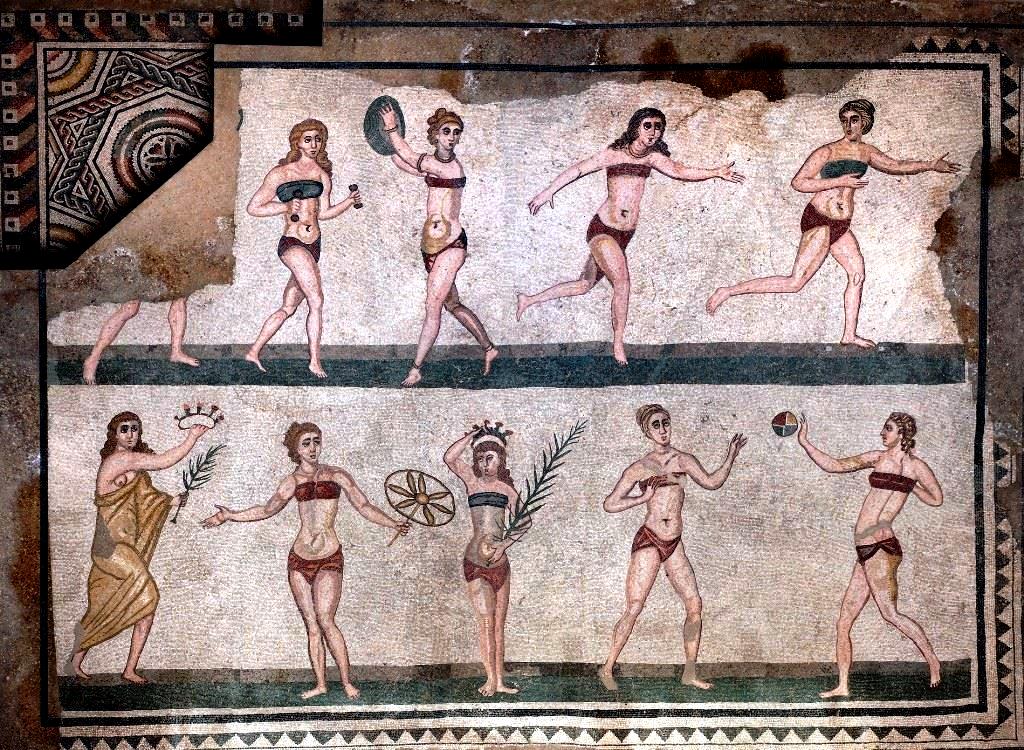
Ancient Roman Sports

Figure 1.-- This is a mosaic in Piazza Armerina, Sicily, dated to 4th century AD. It shows a group of young women engaged in athletics. Two are playing ball, we suspect an exercize activity rather than a game. To us this looks like a kind of gynasia where young unmarried women exercized rather than competed. There were, however, professional atheletes in Rome. We think that they were primrily men, but there could have been some young women as well. Exercize, practice and competitins were normally perfored without clothing. We are not sure if the bikini-type outfits were common or more of a reflection of growing Chrstian influence in the Empire.
|
|
The Greeks basically invented sports. Sports were not as important as gladatorial in Rome, but they did exist and were one of many important Greek influences. As with modern times, some of the games children played reflected sports played mostly by young men, but we see some yoong women involved as well. Sports never, however, reached the enormous popularity of the gladatorial games and equestarian contests (horse and chariot racing). It is the gadiators that had the enormous prestigw of modern atheletes in Rome, nit the atheletes of the day. The Greeks are better known for sports. The Romans at first had nothing like the Greek gymnasia and palaestrae. As the Romans were making the transition from the Republic to the principate, wealthy Romans imitating Greeks, began to build places for exercise in their villas and they referred to them as gymnasia and palaestrae. Emperor Nero was the first to build a public gymnasium in Rome. Emperor Commodus built another. The idea was to introduce Greek gymnastics to Rome, but there seems to have been little success. Rather it is the grand amphitheatres and colossal buildings likes the Coloseum that dominated the Roman mind. We also see stadia in the form of the circus (circi) for racing, both men and horses. A particularly beautiful stadia was built by Domitian. We also see xysti looking rather like porticos, in which the participants in fighting games, wrestlers and boxers, exercised. Other competitions included runnng, jumping, the discus and javelin. The Romans drew a distinction betweem the athletae who pursued sport as a profession and the agonistae who pursued gymnastic exercises only to improving their health and bodily strength. We notice a range of ball games, but they do not seem very important in terms of public exibitions.
CIH

Navigate the Children in History Website:
[Return to the Main ancient Rome play page]
[Return to the Main ancient Rome family and children page]
[Return to the Main ancient Rome page]
[About Us]
[Introduction]
[Biographies]
[Chronology]
[Climatology]
[Clothing]
[Disease and Health]
[Economics]
[Freedom]
[Geography]
[History]
[Human Nature]
[Ideology]
[Law]
[Nationalism]
[Presidents]
[Religion]
[Royalty]
[Science]
[Social Class]
[Bibliographies]
[Contributions]
[FAQs]
[Glossaries]
[Images]
[Links]
[Registration]
[Tools]
[Children in History Home]
Created: 2:22 AM 2/27/2017
Last updated: 2:23 AM 2/27/2017



